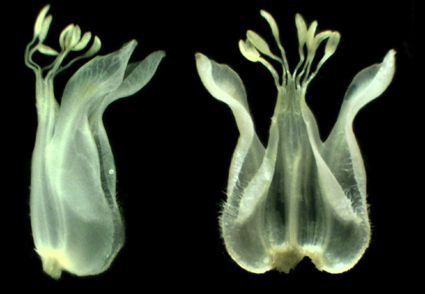Abstract
A comprehensive review of the name Polygala ovata Poiret (1804), basionym of the widely used Asemeia ovata, revealed strong evidence to an alternative interpretation of this name as used by Pastore and Abbott in their Asemeia treatment in 2012. Issues arise from discrepancies between Poiret’s identification in specimens kept in P herbarium as P. ovata, and the original specimen of Nectoux from the Dominican Republican. De Candolle promoted the first attempted to resolve the application of Polygala ovata, however he had different approaches, when included this name in Prodromus, and later in the specimen identification as P. ovata. The present study reevaluates P. ovata identity based on original herbarium specimens, protologue information and original morphological description. The evidence found supports reclassifying P. ovata as a member of genus Hebecarpa instead, and therefore a new combination is proposed here, along with a morphological plate and taxonomic and distribution notes.
References
- Abbott, J.R. (2011) Notes On The Disintegration Of Polygala (Polygalaceae), With Four New Genera For The Flora Of North America. Journal of the Botanical Research Institute of Texas 5 (1): 125–137.
- Abbott, J.R. & Pastore, J.F.B. (2015) Hebecarpa Preliminary synopsis of the genus Hebecarpa (Polygalaceae). Kew Bulletin 70 (3): 1–8. https://doi.org/10.1007/s12225-015-9589-2
- Bennett, A.W. (1895) New South American species of Polygala. Journal of Botany 33: 108–110.
- Blake, S.F. (1916) A revison of the genus Polygala in Mexico, Central America, and the West Indies. Contributions from the Gray Herbarium of Harvard University 47: 1–122. https://doi.org/10.5962/p.335987
- McClellan III, J.E. (1994) Colonialism and Science: Saint Domingue in the Old Regime. Hispanic American Historical 74 (3): 517–519. https://doi.org/10.1215/00182168-74.3.517a
- Bennett, A.W. (1895) New South American species of Polygala. Journal of Botany, British and foreign 33: 108–110.
- Chodat, R.H. (1891) Polygalaceae. In: Durand, T. & Pittier, H. (Eds.) Primitiae florae costaricensis. Bulletin de la Société royale de botanique de Belgique 30: 298–305.
- Chodat, R.H. (1893) Monographia polygalacearum, 2. Memoires de la Société de physique et d’histoire naturelle de Genève 31: 1–500.
- Candolle, A.P. de (1824) In: Candolle, A.P. (Ed.) Prodromus systematis naturalis regni vegetabilis 1. Treuttel & Würtz, Paris, pp. 321–342.
- McClellan III, J.E. (1992) Colonialism and Science: Saint Domingue and the Old Regime. The University of Chicago Press, Chicago, 416 pp.
- Mota, M., Abbott, J.R., Salas, R.M., Neubig, K.M. & Pastore, J.F.B. (2019) Three lonely Argentines: Toward a new generic delimitation in Polygalaceae. Taxon 68: 522–536. https://doi.org/10.1002/tax.12090
- Pastore, J.F.B. & Abbott, J.R. (2012) Taxonomic notes and new combinations for Asemeia (Polygalaceae). Kew Bulletin 67 (4): 801–813. https://doi.org/10.1007/s12225-012-9397-x
- Poiret, J.L.M. (1804) Polygala. In: Lamarck, J.B.A.P.M. (Ed.) Encycl. 5. H. Agasse, Paris, pp. 485–504.


